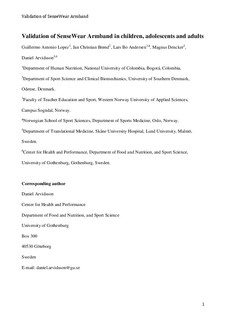| dc.contributor.author | Lopez, Garcia | |
| dc.contributor.author | Brønd, Jan Christian | |
| dc.contributor.author | Andersen, Lars Bo | |
| dc.contributor.author | Dencker, Magnus | |
| dc.contributor.author | Arvidsson, Daniel | |
| dc.coverage.spatial | Denmark, Odense | nb_NO |
| dc.date.accessioned | 2019-04-11T09:58:01Z | |
| dc.date.available | 2019-04-11T09:58:01Z | |
| dc.date.created | 2018-01-15T12:53:53Z | |
| dc.date.issued | 2017 | |
| dc.identifier.citation | Lopez, G. A., Brønd, J. C., Andersen, L. B., Dencker, M., & Arvidsson, D. (2018). Validation of SenseWear Armband in children, adolescents, and adults. Scandinavian Journal of Medicine & Science in Sports, 28, 487-495. | nb_NO |
| dc.identifier.issn | 0905-7188 | |
| dc.identifier.uri | http://hdl.handle.net/11250/2594201 | |
| dc.description | This is the peer reviewed (post-print) version of the following article: Lopez, G. A., Brønd, J. C., Andersen, L. B., Dencker, M., & Arvidsson, D. (2018). Validation of SenseWear Armband in children, adolescents, and adults. Scandinavian Journal of Medicine & Science in Sports, 28(2), 487-495. , which has been published in final form at https://onlinelibrary.wiley.com/doi/full/10.1111/sms.12920. This article may be used for non-commercial purposes in accordance with Wiley Terms and Conditions for Use of Self-Archived Versions. | nb_NO |
| dc.description.abstract | SenseWear Armband (SW) is a multisensor monitor to assess physical activity and energy expenditure. Its prediction algorithms have been updated periodically. The aim was to validate SW in children, adolescents, and adults. The most recent SW algorithm 5.2 (SW5.2) and the previous version 2.2 (SW2.2) were evaluated for estimation of energy expenditure during semi-structured activities in 35 children, 31 adolescents, and 36 adults with indirect calorimetry as reference. Energy expenditure estimated from waist-worn ActiGraph GT3X+ data (AG) was used for comparison. Improvements in measurement errors were demonstrated with SW5.2 compared to SW2.2, especially in children and for biking. The overall mean absolute percent error with SW5.2 was 24% in children, 23% in adolescents, and 20% in adults. The error was larger for sitting and standing (23%-32%) and for basketball and biking (19%-35%), compared to walking and running (8%-20%). The overall mean absolute error with AG was 28% in children, 22% in adolescents, and 28% in adults. The absolute percent error for biking was 32%-74% with AG. In general, SW and AG underestimated energy expenditure. However, both methods demonstrated a proportional bias, with increasing underestimation for increasing energy expenditure level, in addition to the large individual error. SW provides measures of energy expenditure level with similar accuracy in children, adolescents, and adults with the improvements in the updated algorithms. Although SW captures biking better than AG, these methods share remaining measurements errors requiring further improvements for accurate measures of physical activity and energy expenditure in clinical and epidemiological research. | nb_NO |
| dc.language.iso | eng | nb_NO |
| dc.subject | ActiGraph | nb_NO |
| dc.subject | energy expenditure | nb_NO |
| dc.subject | indirect calorimetry | nb_NO |
| dc.subject | multisensor | nb_NO |
| dc.subject | physical activity | nb_NO |
| dc.title | Validation of SenseWear Armband in children, adolescents, and adults | nb_NO |
| dc.type | Journal article | nb_NO |
| dc.type | Peer reviewed | nb_NO |
| dc.description.version | acceptedVersion | nb_NO |
| dc.subject.nsi | VDP::Medisinske Fag: 700::Idrettsmedisinske fag: 850 | nb_NO |
| dc.source.pagenumber | 487-495 | nb_NO |
| dc.source.volume | 28 | nb_NO |
| dc.source.journal | Scandinavian Journal of Medicine & Science in Sports | nb_NO |
| dc.source.issue | 2 | nb_NO |
| dc.identifier.doi | 10.1111/sms.12920 | |
| dc.identifier.cristin | 1542837 | |
| cristin.unitcode | 203,5,2,0 | |
| cristin.unitname | Avdeling for lærarutdanning og idrett - Sogn og Fjordane | |
| cristin.ispublished | true | |
| cristin.fulltext | postprint | |
| cristin.qualitycode | 2 | |
